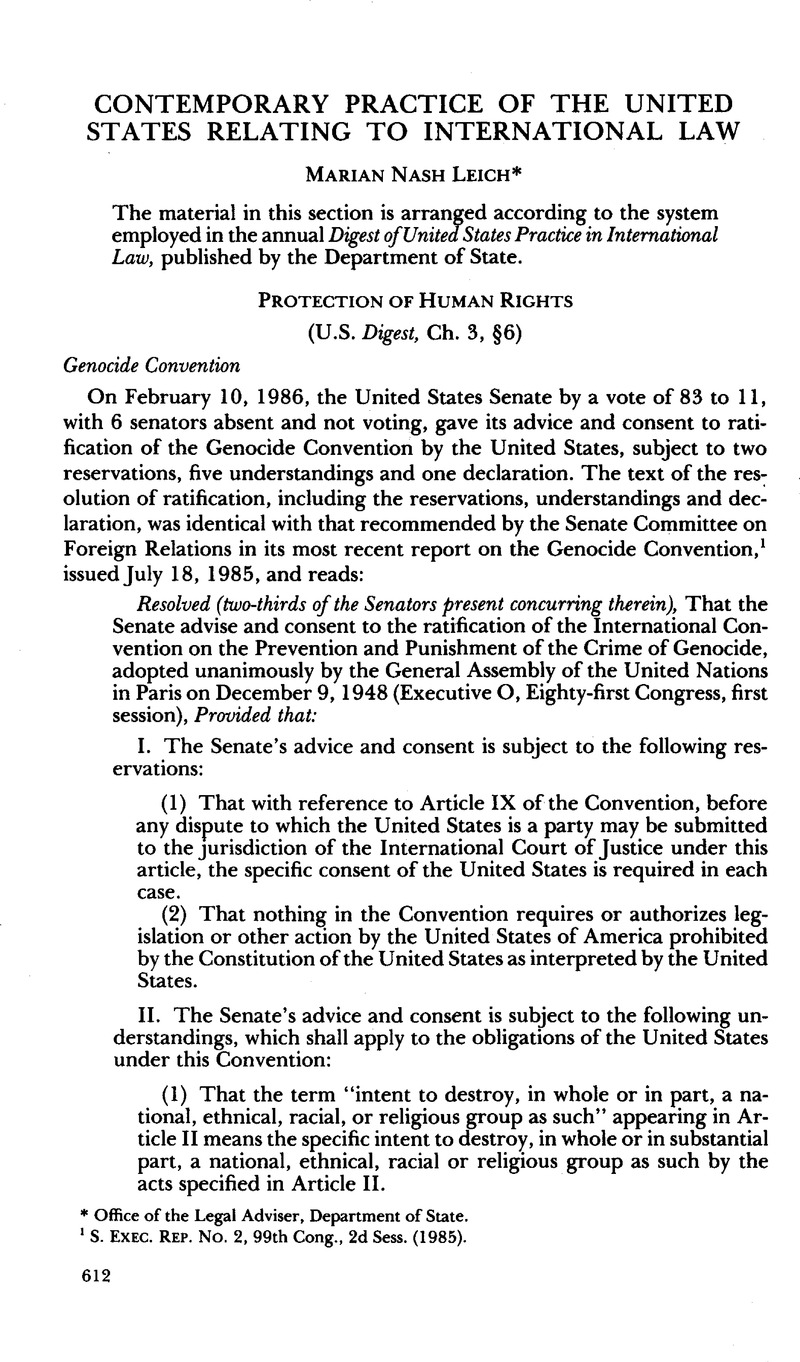Published online by Cambridge University Press: 27 February 2017

page 612 note 1 S. Exec. Rep. No. 2, 99th Cong., 2d Sess. (1985).
page 613 note 2 132 Cong. Rec. S1377–78 (daily ed. Feb. 19, 1986). The executive branch subsequently developed proposed implementing legislation to incorporate the prohibitions of the Convention as substantive offenses under title 18 of the United States Code.
page 615 note 3 In regard to this reservation, the termination of the 1946 U.S. Declaration of acceptance of the Court’s optional compulsory jurisdiction under Article 36(2) of its Statute (see 80 AJIL 163–65 (1986)) had not affected U.S. acceptance of the Court’s jurisdiction under Article 36(1) of its Statute in “all matters specially provided for . . . in treaties and conventions in force.”
page 622 note 4 S. Exec. Rep. No. 2, supra note 1, at 14–26.
page 622 note 5 132 Cong. Rec, supra note 2, at S1380. In introducing the resolution, Senatoŕ Robert J. Dole, the majority leader, pointed out that, by passing it, the Senate would make a strong statement “for the victims of Tibet, Cambodia, and Afghanistan” (referred to in the preamble) and “would reaffirm the position taken by the United States, but resisted by the Soviets . . . when the Convention was being written.” Senator Dole also referred to President Reagan’s support for such an amendment to the Convention, expressed in the President’s letter to Senator Steve Symms, dated Feb. 19, 1986. Id.
page 626 note 1 Dept. of State File No. P86 0043-1337.
page 627 note 2 DEPT. ST. BULL., NO. 2106, January 1986, at 62, 64; The Case of Miroslav Medvid: Hearing Before the House Coram, on Foreign Affairs and its Subcomm. on Europe and the Middle East on H. Res. 314, 99th Cong., 2d Sess. 41-42, 50 (1985).
page 628 note 1 Both Agreements signed Nov. 4, 1966, 17 UST 1909, 1936, TIAS No. 6135.
page 628 note 2 Done Dec. 7, 1944, 61 Stat. 1160, TIAS No. 1591, 15 UNTS 295.
page 628 note 3 Signed Dec. 16, 1970, 22 UST 1641, TIAS No. 7192.
page 628 note 4 Signed Sept. 23, 1971, 24 UST 564, TIAS No. 7570.
page 629 note 5 Dept. of State Files L/T.
page 630 note 1 22 WEEKLY COMP. PRES. Doc. 22 (Jan. 13, 1986), reprinted in 25 ILM 175 (1986).
page 630 note 2 Id.
page 631 note 3 5 51 Fed. Reg. 875-76 (1986).
page 631 note 4 51 Fed. Reg. 1235(1986).
For the Libyan Sanctions Regulations issued by the Office of Foreign Assets Control, Department of the Treasury, in implementation of Executive Order Nos. 12543 and 12544 on Jan. 8 and 14, 1986, respectively, see id. at 1354-59 and 2462-67.
For the General Order under the Export Administration Regulations regarding restrictions on exports involving Libya, 15 C.F.R. 390.7, and related amendments to 15 C.F.R., pts. 385 and 390, issued by the Export Administration, International Trade Administration, Department of Commerce, on Jan. 14, 1986, see id. at 2353-54, reprinted in 25 ILM at 197-98.
page 631 note 5 Dept. of State File Nos. P86 0054-1796 and 0054-1797.
page 632 note 1 UN Doc. S/18016/Rev.l (1986). The vote on the draft resolution was 9 in favor, 5 against (Australia and Denmark in addition to the vetoing permanent members), and 1 abstention. UN Doc. S/PV.2682, at 43 (1986). In explaining the U.S. vote, Ambassador Walters stated:
I wish to stress only this: If the inherent right of self-defence, specifically recognized in article 51 of the Charter, does not include the right to protect one's nationals and one's ships, what does it protect? The idea that a State should be condemned for seeking to protect the lives of its nationals who are subject to armed attack is too absurd for further comment.
What do we find in this draft resolution before us? We see a harmful and potentially disastrous approach that equates the use of terrorism with an act of justified self-defence against terrorism; an approach that condemns acts of the United States against Libya but ignores totally Libya's documented, open, undeniable use of terrorism; an approach that perverts the meaning and intention of the Charter of the United Nations and international law; and, finally, an approach that creates an appearance of even-handedness, but not the reality. Nowhere is Libya asked to refrain from its murderous activities.
…We are not dealing here with the acts of individuals or groups, but rather with a State policy to use force by clandestine means or, as one speaker in the debate put it, "war by another name"….
Id. at 31-32; U.S Mission to the United Nations [USUN] Press Release 34(Rev.l)(86), Apr. 23, 1986.
page 633 note 2 UN Doc. S/17990 (1986).
page 634 note 3 From Mar. 23 to 25, 1986, U.S. forces exercised freedom of navigation and overflight rights under international law on and over the high seas in the Gulf of Sidra. In response to attacks from Libyan missile installations, the U.S. forces took limited measures of self-defense necessary to protect themselves from continued attack. President Reagan reported the matter to Congress in identical letters dated Mar. 26, 1986, to Speaker of the House Thomas P. O'Neill, Jr., and Senator Strom Thurmond, President pro tempore of the Senate. For the text, see 22 WEEKLY COMP. PRES. DOC. 423 (Mar. 31, 1986).
page 636 note 4 USUN Press Release 29(86), Apr. 15, 1986; UN Doc. S/PV.2674 (1986).
page 636 note 1 Bureau of Public Affairs, Department of State, Current Policy No. 832, The War Powers Resolution and Antiterrorist Operations 1 (1986) (Statement of Legal Adviser Abraham D. Sofaer, Apr. 29, 1986).
page 637 note 2 Id.
page 638 note 3 Id. at 1-2.
page 643 note 4 Id. at 2-4.
page 644 note 5 Id. at 4.
page 644 note 1 See 80 AJIL 342-44 (1986).
page 644 note 2 51 Fed. Reg. 10,494 (1986).